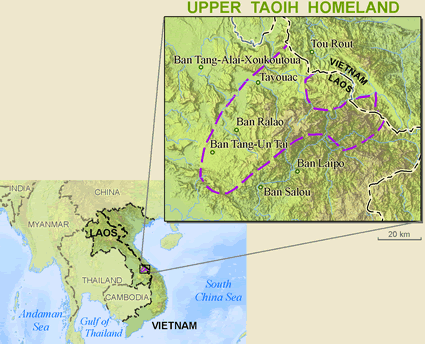Most of the Ta Oi in Vietnam speak a dialect that is only partially mutually intelligible with the Ta Oi in Laos. One source says people from these two groups cannot understand each other "until speakers have had at least two weeks contact."
After the end of the U.S.-Vietnam War, a small number of Ta Oi families were allowed into the United States as refugees. Today, Ta Oi live in the Stockton, CA.; and Birmingham, NY, areas. Most remain either in Vietnam or Laos. The majority are concentrated in Ta-Oy District in the eastern part of Saravan Province towards the Vietnam border. Others live in Savannakhet and Kekong provinces. Since 1989 some Ta Oi have migrated down the mountains to the Bolaven Plateau.
Most of the Upper Ta Oi are farmers. Those living in the hills continue to use the slash and burn method of cultivation; however, some now grow wet rice. Rice is their staple food, but they also grow maize, manioc, sweet potatoes, beans, and tobacco. Their productivity depends on the amount of rainfall they receive. The Upper Ta Oi tribe has more cash income than most of the other mountain peoples because they are skilled at hunting and taming elephants. There are also irrigation projects, new uses of agricultural machinery, and other local industries that have provided them with better crop yields. They also dig ponds and raise fish.
The Upper Ta Oi live in villages, or vel. Each village comprises a few houses built on stilts, and several families live in each house. Every village also has a large community home, which serves as a reception room or meeting place. This home is typically decorated with animal horns and bird feathers.
In Upper Ta Oi society, there is a clear distinction between the rich and the poor. A spirit of community prevails. The Upper Ta Oi are divided into several clans. They will not marry outside their tribe; however, some of the Upper Ta Oi have intermarried with other ethnic groups, people whom they call Ya. (The word Ya was originally the Taoih name for the French. It literally means "an incarnation of powerful spirits in human form.") The Upper Ta Oi live in a patrilineal society where the line of descent is traced through the males. The Upper Ta Oi highly respect maternal uncles. The uncles care for their nieces by supplying them with food and clothes, and also by organizing their weddings. After marriage, the uncle becomes the couple's advisor.
Prior to communism, the status of Upper Ta Oi women was relatively low. Since that time, however, their status has become higher. They now take part in social activities and may even enlist in the armed forces.
Folk music plays a big part in the daily lives of the Upper Ta Oi. The villagers love to sing. According to their mood, they sing lullabies, love songs or classical songs. Their musical instruments include gongs, wind instruments and stringed instruments.
The Ta Oi, who practice a combination of animism and shamanism, are one of the most demon-oppressed groups in all of Laos. In 1890 one Frenchman recorded the experience of a Ta Oi animistic ritual (which has changed little even today): "In a clearing a certain number of them made a circle around a beer jar. To the bowl of the receptacle a lighted wax candle was fixed. Chickens with their throats cut were lying on the ground. An elder, with his head shaved close to the skull, made invocations to the spirits and in turn, the warriors passed in front of him, presenting their arms to him."
They perform a complex ritual after a Ta Oi person dies.... "A shaman is brought in to help the soul of the deceased find its way to the next life. Ta Oi women are sometimes buried in their traditional clothing, and with ornaments made of copper, silver, ivory or glass. Several years after the burial, the remains of the body are dug up, washed, decorated, and placed in a funeral house outside the fence of their former home."
Although there are now between 350 to 500 Ta Oi Christians (mostly Catholics) in Laos, most Ta Oi oppose the gospel. In Vietnam the Ta Oi are a completely unreached people group. A few years ago they attacked Bru evangelists who tried to bring the gospel to them, and drove them out of the area.
Ask the Holy Spirit to soften the hearts of the Ta Oi to receive the gospel.
Pray that God would raise up Christians to focus on reaching all three ethnic groups among the Ta Oi minority.
Pray many strong churches would soon emerge in their midst.
Ask the Lord to heal the wounds of fear, suspicion of outsiders, and hatred that have kept the Ta Oi from knowing God.
Scripture Prayers for the Ta Oi, Upper in Laos.
| Profile Source: Joshua Project |











